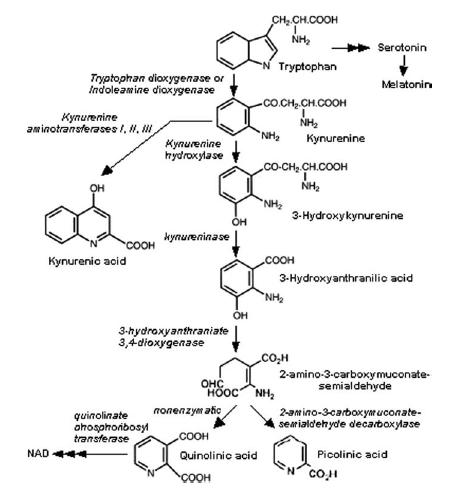Activation of the kynurenine pathway (KP) of tryptophan metabolism results from chronic inflammation and is known to exacerbate progression of neurodegenerative disease. To gain insights into the links between inflammation, the KP and multiple sclerosis (MS) pathogenesis, we investigated the KP metabolomics profile of MS patients. Most significantly, we found aberrant levels of two key KP metabolites, kynurenic acid (KA) and quinolinic acid (QA). The balance between these metabolites is important as it determines overall excitotoxic activity at the N-methyl-D-Aspartate (NMDA) receptor. We also identified that serum KP metabolic signatures in patients can discriminate clinical MS subtypes with high sensitivity and specificity. A C5.0 Decision Tree classification model discriminated the clinical subtypes of MS with a sensitivity of 91%. After validation in another independent cohort, sensitivity was maintained at 85%. Collectively, our studies suggest that abnormalities in the KP may be associated with the switch from early-mild stage MS to debilitating progressive forms of MS and that analysis of KP metabolites in MS patient serum may have application as MS disease biomarkers.
Current Evidence for a Role of the Kynurenine Pathway of Tryptophan Metabolism in Multiple Sclerosis.
In this study the authors looked for metabolites of the kynurenine pathway of Tpryptophan. They looked in the blood and they
decreases in kynurenic acid and Quinolic acid increases
They looked for metabolites and found a few that may help distinguish different phases of MS. There is am implication that these metabolites are associated with the NMDA glutamate receptor excitotoxicty which is a way that glutamate overload can kill nerves by exciting them to destruction.
Blocking this stops nerves working properly, but we have a an idea how to block this...watch this space.
However one wonders about the relationship of blood to the CSF?
.
How are we going to use the information?
It could be useful to distinguish RRMS from PPMS as some could use it to perhaps not treat someone predicted to get RRMS with drug X
So whilst interesting they have found correlations at a population level and occurs with the countless imaging studies published are they going to be great to predict what happens to the individual.
As the media claim they are making a product, you can look at patent WO2015/008111 published 2 years ago.
So you do a test what is going to happen to individual in the red circle are they going to get RRMS/PPMS? So how do you base your treatment descisions?
So you put a number of differnt tests into the analysis and the predictive value goes up and is not bad for RRMS and PPMS.
As you would expect SPMS is a bit more wooly, but would you want to be one of the 15% (in some instances) when it it wrong,
Being labelled with SPMS can be a stop singnal for your DMT
However ProfG will claim that making this call ia an art and you have to use many different bits of information to make that call
The key is to find the biology
decreases in kynurenic acid and Quinolic acid increases
They looked for metabolites and found a few that may help distinguish different phases of MS. There is am implication that these metabolites are associated with the NMDA glutamate receptor excitotoxicty which is a way that glutamate overload can kill nerves by exciting them to destruction.
Blocking this stops nerves working properly, but we have a an idea how to block this...watch this space.
However one wonders about the relationship of blood to the CSF?
.
How are we going to use the information?
It could be useful to distinguish RRMS from PPMS as some could use it to perhaps not treat someone predicted to get RRMS with drug X
So whilst interesting they have found correlations at a population level and occurs with the countless imaging studies published are they going to be great to predict what happens to the individual.
As the media claim they are making a product, you can look at patent WO2015/008111 published 2 years ago.
So you do a test what is going to happen to individual in the red circle are they going to get RRMS/PPMS? So how do you base your treatment descisions?
So you put a number of differnt tests into the analysis and the predictive value goes up and is not bad for RRMS and PPMS.
As you would expect SPMS is a bit more wooly, but would you want to be one of the 15% (in some instances) when it it wrong,
Being labelled with SPMS can be a stop singnal for your DMT
However ProfG will claim that making this call ia an art and you have to use many different bits of information to make that call
The key is to find the biology



